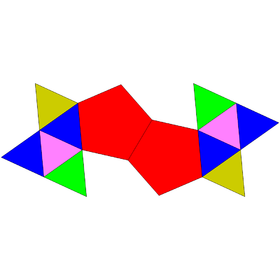Metabidiminished icosahedron
| Metabidiminished icosahedron | |
|---|---|
 | |
| Type | Johnson J61 - J62 - J63 |
| Faces | 3x2+4 triangles 2 pentagons |
| Edges | 20 |
| Vertices | 10 |
| Vertex configuration | 2(3.52) 2+4(33.5) 2(35) |
| Symmetry group | C2v |
| Dual polyhedron | - |
| Properties | convex |
| Net | |
 | |
In geometry, the metabidiminished icosahedron is one of the Johnson solids (J62).
A Johnson solid is one of 92 strictly convex polyhedra that is composed of regular polygon faces but are not uniform polyhedra (that is, they are not Platonic solids, Archimedean solids, prisms, or antiprisms). They were named by Norman Johnson, who first listed these polyhedra in 1966.[1]
The name refers to one way of constructing it, by removing two pentagonal pyramids from a regular icosahedron, replacing two sets of five triangular faces of the icosahedron with two adjacent pentagonal faces. If two pentagonal pyramids are removed to form nonadjacent pentagonal faces, the result is instead the pentagonal antiprism.
External links
- ^ Johnson, Norman W. (1966), "Convex polyhedra with regular faces", Canadian Journal of Mathematics, 18: 169–200, doi:10.4153/cjm-1966-021-8, MR 0185507, Zbl 0132.14603.
